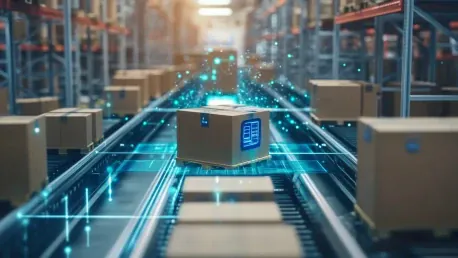As supply chains continue to evolve rapidly, integrating advanced technologies has become essential for organizations aiming to enhance operational efficiency and foster innovation. The latest technological advancements are unlocking significant opportunities in supply chain management, transforming the way businesses operate and compete in today’s fast-paced environment. This article delves into the key supply chain technology trends currently shaping the industry, focusing on connectivity, intelligence, and workforce productivity. By embracing these trends, companies can navigate complexities more effectively and achieve strategic outcomes.
Transformative Potential of Connectivity and Intelligence
Ambient Invisible Intelligence
Ambient invisible intelligence represents a breakthrough in real-time tracking and sensing technologies, utilizing ultra-low-cost, small smart tags, and sensors. This innovation enables end-to-end visibility across supply chains, providing critical insights into the status and location of products, particularly perishable items that require stringent monitoring to comply with environmental regulations. By implementing ambient invisible intelligence, organizations can enhance traceability, reduce spoilage, and ensure optimal conditions throughout the product lifecycle. Furthermore, this technology supports seamless integration with existing systems, facilitating proactive decision-making and improving overall supply chain resilience.
These intelligent tags and sensors also play a pivotal role in cost management by offering affordable solutions for large-scale deployment. Businesses can leverage this technology to gain comprehensive visibility without significant financial burdens, thereby driving efficiency and optimization. Real-time data generated through these devices allows for improved inventory management, enabling precise forecasting and minimizing overstock or stockouts. Consequently, ambient invisible intelligence becomes a cornerstone for operational excellence and regulatory compliance within supply chains.
Agentic AI
Agentic AI is revolutionizing supply chain operations by introducing virtual AI agents capable of autonomously executing decisions. These AI agents enhance adaptability and efficiency by dynamically adjusting inventory levels and resource allocation based on real-time demand forecasts. The implementation of agentic AI empowers organizations to respond swiftly to market changes, optimize stock availability, and reduce lead times. This technology substantially improves supply chain agility, allowing businesses to maintain competitive advantages in a volatile market landscape.
Additionally, agentic AI facilitates intelligent decision-making processes, offering insights and recommendations that drive strategic initiatives. By analyzing vast datasets and learning from historical trends, AI agents can provide actionable insights that support optimization across various supply chain functions. This approach helps in identifying patterns, predicting future demands, and mitigating risks, resulting in enhanced operational efficiency. Overall, agentic AI stands as a transformative force, enabling organizations to achieve higher productivity and competitiveness through intelligent automation.
Fostering Enhanced Workforce Productivity
Augmented Connected Workforce (ACWF)
The augmented connected workforce represents a significant leap in workforce productivity within the supply chain sector. Digital tools employed in ACWF are designed to enhance decision accuracy, reduce variability, and bridge skill gaps among employees. By digitizing standard operating procedures, organizations can expedite employee onboarding, ensuring that new hires rapidly become proficient in their roles. This acceleration in onboarding not only boosts productivity but also helps in maintaining consistent operational quality across manufacturing and logistics functions.
Moreover, the use of augmented reality (AR) and virtual reality (VR) within ACWF enhances training programs, equipping the workforce with immersive experiences for better understanding complex tasks. These technologies facilitate hands-on learning, allowing employees to visualize processes and practice them virtually before executing in real scenarios. Consequently, ACWF drives efficiency, reduces error rates, and strengthens workforce capabilities, ultimately contributing to overall supply chain success. By embracing ACWF, businesses can leverage technology to build a more skilled, adaptable, and resilient workforce.
Multimodal UI
The introduction of multimodal user interfaces marks a significant innovation in improving user experience and operational efficiency within supply chains. Multimodal UIs enable interaction through multiple communication modes, such as voice-activated controls and gesture-based interfaces. These advanced interfaces streamline operations by making interactions more intuitive and accessible, enhancing productivity and facilitating seamless workflows. Particularly within logistics, multimodal UIs empower employees to manage tasks more efficiently using natural language commands and gestures, reducing the need for extensive manual input.
Implementing multimodal UI also contributes to better handling of logistics activities by allowing employees to access information and execute commands more rapidly. The versatility of these interfaces supports diverse operational requirements, from inventory management to transportation coordination. Multimodal UI promotes greater user engagement and satisfaction, as employees can perform their duties with ease and precision. These innovations reflect the importance of user-centric design in technology, driving improvements in both efficiency and workforce morale.
Innovations in Operating Models
Polyfunctional Robots
Polyfunctional robots have emerged as versatile assets within supply chains, capable of performing multiple tasks and adapting to new roles as needed. These robots provide flexible workforce solutions, particularly in warehouse environments, where they can handle sorting, packaging, and other essential activities. By reducing human intervention, polyfunctional robots optimize workflows, enhance accuracy, and lower operational costs. Their ability to adapt to various functions makes them indispensable in dynamic supply chain settings, where agility and scalability are crucial for success.
The adoption of polyfunctional robots also contributes to improved resource allocation, as these machines can be deployed across different areas based on operational demands. This adaptability ensures that supply chains remain resilient to fluctuations and disruptions, maintaining consistency in performance. Additionally, the integration of AI and machine learning within polyfunctional robots enables continuous improvement through data-driven insights, allowing for refined processes and superior outputs. Overall, these robots represent a forward-thinking approach to workforce management, offering reliable and efficient support for diverse supply chain operations.
Autonomous Data Collection
Autonomous data collection technologies, such as drones and mobile robots, have become instrumental in boosting productivity and reducing labor within supply chain operations. Drones, for instance, are deployed for inventory checks, minimizing the time and risk associated with manual audits. These autonomous machines capture data from various points in real-time, providing accurate and comprehensive insights into inventory levels, asset conditions, and logistical flows. The use of autonomous data collection technologies streamlines processes, enhances accuracy, and frees up human resources for more strategic tasks.
Moreover, autonomous data collection technologies contribute to better decision-making by delivering precise and timely information critical for optimizing supply chain activities. The ability to collect data autonomously ensures that organizations can maintain high levels of accuracy and consistency, ultimately supporting operational efficiency. These technologies are particularly valuable in environments where speed and precision are essential, such as high-turnover warehouses or complex distribution networks. By leveraging autonomous data collection, businesses can elevate their operational capabilities and achieve new benchmarks in efficiency and innovation.
Decision Intelligence (DI)
Decision intelligence integrates decision modeling, AI, and analytics to support, augment, and automate decision-making within supply chains. This technology helps supply chain leaders understand and improve decision processes based on feedback and comprehensive data analysis. Decision intelligence tools provide insights into various scenarios, empowering leaders to make informed choices that align with strategic objectives. By automating repetitive decision-making tasks, DI frees up valuable time for higher-level strategic thinking, driving innovation and operational excellence.
The implementation of decision intelligence also enhances predictive capabilities, allowing organizations to anticipate market trends, demand fluctuations, and potential risks. This forward-looking approach helps in optimizing logistics routes, warehouse layouts, and resource allocation, contributing to greater overall efficiency. Moreover, DI tools facilitate continuous improvement by learning from historical data and adapting to emerging patterns. As a result, businesses can maintain a proactive stance in managing supply chain complexities, ensuring resilience and competitiveness.
Intelligent Simulation
Intelligent simulation enhances traditional simulation models by integrating AI and machine learning, boosting predictive capabilities and decision-making processes. This technology allows companies to optimize logistical routes, warehouse layouts, and operational strategies, resulting in improved efficiency and reduced costs. Intelligent simulation models analyze vast amounts of data to provide accurate forecasts and identify optimal configurations for various supply chain activities. By leveraging this technology, organizations can make data-driven decisions that significantly enhance their operational performance.
Furthermore, intelligent simulation supports continuous improvement by providing feedback on implemented strategies and identifying areas for refinement. This iterative process ensures that supply chain operations remain agile and responsive to changing conditions. Intelligent simulation also enables scenario planning, allowing leaders to evaluate different approaches and select the best course of action based on comprehensive analyses. The ability to predict and adapt to future trends positions businesses for sustained growth and competitive advantage, solidifying the importance of intelligent simulation in contemporary supply chain management.
Strategic Pathways for Innovation and Excellence
As supply chains evolve rapidly, integrating advanced technologies is crucial for organizations wanting to boost operational efficiency and encourage innovation. The latest technological developments are creating significant opportunities in supply chain management, changing how businesses function and compete in today’s fast-paced environment. This article explores the key supply chain technology trends currently influencing the industry, particularly focusing on connectivity, intelligence, and workforce productivity. These trends include the increased use of Internet of Things (IoT) devices, artificial intelligence (AI) for predictive analytics, and automation for streamlining tasks. By adopting these advancements, companies can better manage complexities and achieve their strategic goals. Moreover, these technologies enhance real-time decision-making, improve logistics, and provide data-driven insights. The growing use of cloud-based platforms and blockchain for transparent and secure transactions is also transforming supply chain dynamics. Embracing these trends allows businesses to stay competitive and responsive to market demands, ensuring long-term success.









